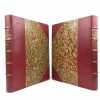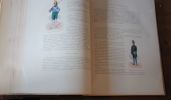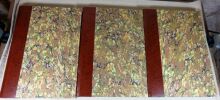-
Type
Book (14782)
Disk (1)
Drawings (2)
Engraving (13)
Magazine (171)
Manuscript (9)
Maps (2)
Music sheets (619)
Old papers (9)
Photographs (72)
Posters (2)
-
Latest
Last 24h (27)
Last 3 days (13)
Last month (99)
Last week (40)
-
Language
Dutch (1)
English (40)
Finnish (6)
French (15609)
German (19)
Italian (3)
Russian (2)
Spanish (2)
-
Century
16th (10)
17th (64)
18th (767)
19th (3081)
20th (6059)
21st (630)
-
Countries
Belgium (464)
Canada (31)
China (14)
Côte d'Ivoire (1)
Denmark (1488)
France (11837)
Italy (169)
Switzerland (1678)
-
Syndicate
ALAC (31)
CLAM (2)
CLAQ (29)
ILAB (8426)
NVVA (843)
SLACES (843)
SLAM (5751)
SNCAO (132)
Problèmes de défense du sud-est asiatique (Le Viet-Nam et ses voisins)
, Paris, Nouvelles Editions latines 1967, 157pp., signé, bel état, X22151
Ein Hochzeitsspiel.
Bern, A. Francke Verlag 1906, 205x140mm, 159Seiten, broschiert. Auf schönem Papier (Velin) gedruckt. Kleine Druckstellen an den Seitenrändern des oberen Buchdeckels und Handschriftliche Eintragungen auf dem oberen Rand des oberen Deckblatts, sonst ansonsten schönes Exemplar.
Pour un paiement via PayPal, veuillez nous en faire la demande et nous vous enverrons une facture PayPal
Convention entre quatre sociétés d'Avignon (Maumet , Farge,, Carcassonne, Reynier et Guyon) et le sieur Rogier de Monteux de la fourniture d'un remplaçant s'il est désigné par le sort pour l'Armée.
feuille 21 x 30 cm, fomulaire imprimé, entierement rempli portant la signature des parties, et le récépissé de la somme de cinq cents francs. 1826,
Le conscrit est du lieu de Monteux.
Phone number : 33 (0)6 77 77 12 33
Islamic and Native Weapons of Colonial Africa
Indigo Publishing 2007 In-4 28,5 x 28,5 cm. Reliure de l’éditeur cartonnée et illustrée sous jaquette illustrée. 682 pp., 740 illustrations et cartes en couleurs dans et hors-texte. Exemplaire en bon état.. Poids sans emballage : 4500 grammes. L’un des ouvrages les plus exhaustifs jamais publiés sur les diverses armes du continent africain du Soudan à l’égypte de 1800 à 1960 présentées pays par pays.
Texte en anglais. L’un des ouvrages les plus exhaustifs jamais publiés sur les diverses armes du continent africain du Soudan à l’égypte de 1800 à 1960 présentées pays par pays. Bon état d’occasion
Souvenirs et récits d’un aérostier militaire de l’armée de la Loire 1870-1871. Avec une lettre autographe du général Chanzy et de nombreuses illustrations de V.-A. Poirson
Maurice Dreyfous 1891 In-4. Cartonnage éditeur pleine percaline rouge, dos et premier plat orné d’un décor polychrome, plats biseautés, tranches dorées, 356 pp. Cartonnage passé, gouttière irrégulière.
Aérostier et aventurier scientifique, Gaston Tissandier (1843-1899), durant le siège de Paris, est le quatrième à partir dans un ballon monté, le Céleste, qui atterrit à Dreux. Bon état d’occasion
A nos Soldats. Soins et Conseils.
Limoges. Non daté. In-16. Relié. Etat d'usage, Couv. défraîchie, Dos frotté, Intérieur frais. Paris, Limoges, Henri Charles-Lavauzelle, s.d. (vers 1890), in 16, reliure éditeur, catalogue Berger-Levrault in fine, 213 pp.Couverture tachée et salie.. . . . Classification Dewey : 355.021-Militaria
HM-035 - Lieu d'édition : Paris Classification Dewey : 355.021-Militaria
Précis, ou Histoire abrégée des guerres de la Révolution française, depuis 1792 jusqu'à 1815; Par une Société de Militaires, sous la direction de M. Tissot. SECONDE PARTIE
Paris RAYMOND 1821 un volume in-8°, (4) 682 pp. (422 - 1102). Reliure en pleine basane fauve marbrée, dos lisse orné, filet, dent-de-rat et palmette dorés sur les plats, tranches jaunes, gardes cailloutées (reliure époque). (dos frotté, manque à la coiffe de tête et à la pièce de tomaison, charnière fendillée, rousseurs). Seconde partie seule.
AVENTURES DE CORPS DE GARDE - SCENES DE LA VIE MILITAIRE EN PRUSSE.
DENTU ET CIE. 1887. In-8. Relié demi-cuir. Etat d'usage, Coins frottés, Dos abîmé, Rousseurs. 539 pages augmentées de nombreuses illustrations en noir et blanc in et hors texte - Manque pages de garde et page de faux-*titre - 1 étiquette collée sur le 1er contre-plat - dos partiellement manquant.. . . . Classification Dewey : 355.021-Militaria
Classification Dewey : 355.021-Militaria
AVENTURES DE CORPS DE GARDE. SCENES DE LA VIE MILITAIRE EN PRUSSE
Dentu Paris, Dentu et Cie 1887. In-8 broché couverture illustrée de 539 pages illustrées.
Toutes les expéditions sont faites en suivi au-dessus de 25 euros. Expédition quotidienne pour les envois simples, suivis, recommandés ou Colissimo.
Aventures de corps de garde. Scènes de la vie militaire en Prusse d’après Haclaender. Huitième édition.
Paris, Dentu, 1887, gr. in-8vo, 4 feuille + 539 p. + 5 p. n.n., illustrée en noir/blanc, rousseurs épars, reliure en d.-cuir de l’époque, couverture de la brochure orig. devant conservée. Bel exemplaire.
Image disp.

(SLACES, NVVA)
Phone number : 41 (0)26 3223808
Histoire de la maison militaire du roi de 1814 à 1830, avec un Résumé de son Organisation et de ses Campagnes sous l’Ancienne Monarchie et 84 Dessins en couleurs, hors Texte.
1890 Paris, Baudry et Cie, 1890.
2 volumes in-folio (36,5 x 28 cm), demi-maroquin rouge à coins (reliure de l’époque), dos à nerfs orné, triple filet en bordures, tranche de tête dorée, titre en rouge et noir, [4]-viii-331-[1] ; [2]-338-[2] pages (complet). Bon état. ÉDITION ORIGINALE, illustrée de 84 planches hors-texte en couleurs. Exemplaire n°90, imprimé pour M. Edmond Baudry. Eugène Titeux (1838-1904) est un officier militaire et historien français, qui s’attèle ici à décrire le fonctionnement précis de l’armée française durant la Restauration, et en particulier sous le règne de Louis XVIII et Charles X. Il évoque notamment la garde rapprochée du roi, les Cent-Suisses, la cavalerie, ou encore les maréchaux. BEL EXEMPLAIRE.
Saint-Cyr et l'Ecole Spéciale Militaire en France. Fontainebleau - Saint-Germain, depuis leur fondation jusqu'en 1897. Préface par le Général Du Barail.
Paris, Société de Propagation des Livres d'Art, 1914-1915. Grand in-4 demi-reliure basane verte (reliure postérieure), plats skivertex, dos à nerfs, plats et dos conservés, 838 pp., 107 reproductions en couleurs, 264 gravures en noir et 26 plans. Imprimé à 600 exemplaires numérotés (celui-ci nominatif), ce bel ouvrage est magnifiquement illustré d'après les aquarelles et dessins de l'auteur.
La librairie fermera ses portes en 2025. Des remises de 25 à 50 % peuvent s'appliquer au cas par cas.
Saint-Cyr et l’Ecole spéciale militaire en France.
Maison Didot 1898 In-folio, toile amateur muette, VIII- 838 pp. Imprimé sur papier couché. 107 reproductions en couleurs, 264 gravures en noir et 26 plans d’après les aquarelles et dessins de l’auteur. Humidité et ternissures éparses, fortes in fine. En l’état.
Préface par le général Du Barail. Edition originale de cette somme documentaire pour l’école depuis leur fondation jusqu'en 1897. On joint une belle gravure sur soie en couleurs pour le bal de la St Cyrienne du 28 février 1914. d’après M. Ritter Etat correct d’occasion
Saint-Cyr et l’École Spéciale Militaire en France, Fontainebleau, Saint-Germain, depuis leur fondation jusqu’en 1897.
Paris, Société dePropagation des livres d'Art, Paris, Société dePropagation des livres d'Art1914-1915 ; grand in-8, broché, couverture imprimée. 4 ff. n. ch., x pp., portrait, viii pp., 838 pp., 107 illustrations en couleurs, 264 gravures en noir et 26 plans in et hors-texte.Préface par le général Du Barail, illustrations d’après les aquarelles et dessins de l’auteur.Fente sans manque de papier au dos.
Saint-Cyr et l'école spéciale militaire en France, Fontainebleau - Saint-Germain depuis leur fondation jusqu'en 1897.
Complet en trois volumes cartonnages de l'éditeur, 30X22 cm, 2002, 264+576+438 pages, nombreuses illustrations en noir (pas d'illustrations en couleurs), les reprints éditions Lavauzelle. Très bon état.
"La guerre de Corée (2); l'Amérique paie ses erreurs : Pearl Harbor."
sans lieu, sans date, (ca 2000). 14 x 24, 80 pp., quelques illustrations, broché, état neuf.
tome 2 seul.
"La guerre de Corée (3); Les plans d'expansion des Japonais : l'opération ""Southern Area""."
sans lieu, sans date, (ca 2000). 14 x 24, 80 pp., nombreuses illustrations illustrations, broché, état neuf.
tome 3 seul.
La guerre de Corée (4) Les fruits du blitzkrieg japonais.
sans lieu, sans date, (ca 2000). 14 x 24, 80 pp., nombreuses illustrations illustrations, broché, état neuf.
tome 4 seul.
TOBLER, Salomon / KELLER, Gottf. / WEBER, Rob. / KÜBLER, Jacob (Hrsg.):
Reference : 138441aaf
Lieder des Kampfes zum Besten der Hinterlassenen im letzten Kampfe gefallener eidgenössischer Wehrmänner.
Winterthur, Hegner, älter, 1848, kl. in-8vo, (12.5x18 cm.), 2 Bl. + 207 S., Papier bedingt leicht stockfleckig, Original-Leinenband. Rücken mit Goldaufdruck.
Barth 7898.

(SLACES, NVVA)
Phone number : 41 (0)26 3223808
La guerre des Deux Roses.
Tours, Ad. Mame et Cie. 1851, 215x180mm, 380pages, Reliure d’éditeur percaline ornée.
Rousseurs marginales. Pour un paiement via PayPal, veuillez nous en faire la demande et nous vous enverrons une facture PayPal
Die Vertheidigung von Sebastopol. Nach authentischen Quellen dargestellt, unter Leitung des general-Lieutnant, General-Adjutanten S.M. des Kaisers. Uebersetzung aus dem Russischen. 2 Theile in 4 Bde. (1. Theil: Bd. 1-2 2. Theil: Bd. 1-2). + Atlas der...
St-Pétersburg, Thieblin & Co., 1864-72. 4to., Elephant-folio (82 x 57 cm.) a. folio (54 x 42 cm.). Textvolumes: 4 contemp hcalf. Gilt spines. Gilt lettering. Stamps on title-pages. 6,III,XXXVIII,323,(2)(4),III,324-727,(2) - (4),II,III,448,(2)"VIII,546,(2) pp.+ ""Anhänge"" 129 pp. (in ""Erster Theil""). Wide-margined, internally clean and fine. - 2 Atlases in elephant-folio: both with printed title-page and printed leaf: ""Erklaerung der Karten un Plaenen"". Both in original printed portfolios with ties (wear to extremities). The first having 7 maps (a preliminary atlas ??), the second having 14 (I-XIV) maps and some of the 7 maps from the first are repeated in the second portfolio. The maps and plans numbered XV-XXVII are bound in 2 contemp. hcalf. As some of the maps in the first atlas are not repeated in the second, the whole set of maps and plans exceeds 30. The larger maps are lithographed with toning, some of the plates and plans are engraved. Some of the larger maps are strenghtened in folding on verso. A few plans are handcoloured.A supplementary-volume attached: Atlas der Plaene und Zeichnungen zu der beschreibung der vertheidigung von Sebastopol, nebst Angabe der Geschuetz-Armierung. Sanct-Petersburg, 1864. Folio-oblong. Original printed wrappers. Having 8 (of 27 ??) lithographed plates.
Scarce first German edition. During the Crimean War, Totleben was instrumental in organizing the defense of Sevastopol’ (1854-55). Improving on the theories of A. Z. Teliakovskii, he adapted fortifications to the terrain, siting them so as to preclude outflanking" arranged batteries to fire at a single target made use of lodgments to prepare firing positions and made extensive use of buried land mines.
Partition de la chanson : Beau tambour-major (Le) De tamboer-majoor
Partitions sur le Militaria Hit Music 1954
Bon état Petit format
Patrouilles de monde
EPA. Non daté. In-Folio. Relié. Bon état, Couv. convenable, Dos satisfaisant, Intérieur frais. 127 pages. Nombreuses photos en couleurs hors texte. Une déchirure sur la coiffe en-tête de la jaquette.. Avec Jaquette. . . Classification Dewey : 355.021-Militaria
Classification Dewey : 355.021-Militaria
 Write to the booksellers
Write to the booksellers

















